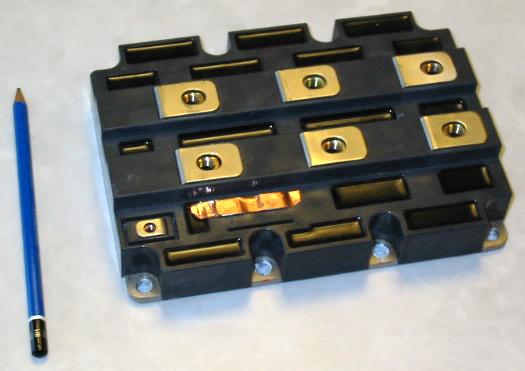The Significance Of Voltage Ratings In Power Module Selection
The Significance of Voltage Ratings in Power Module Selection

Power module image source Wikipedia
Determining the voltage rating of power modules is usually the first step that is taken by a manufacturer and even buyer of electronic products. As a manufacturer, information on voltage rating ensures that you build electronic equipment or devices that will execute their function safely in a particular application. If the voltage rating is too close to the operating voltage of the device, there is a high risk that the device will get damaged due to overvoltage. Buyers should also be aware of the voltage rating of the power modules. This is vital for the safety and performance of the device.
There are many other reasons why voltage rating is important for power modules. In this article, we are going to look at each of these reasons. We will also discuss key elements of voltage ratings that are considered when choosing power modules.
Functionality of device and application
Each electronic device or product is designed to execute a particular task. The tasks can be performed only when the right amount of power is supplied to the components. The power supply in the system will always depend on its voltage rating. Power modules that have the right voltage ratings will always perform to the optimum levels as required. The reverse is true for the wrong voltage rating. The device may not be able to function at all. Even if it works, its performance will be lower than the expectations.
Safety and protection
Safety is another reason why you should pay full attention to the voltage ratings of the power modules. This is closely accompanied by the protection of power systems. With the right voltage ratings in the power modules, you can be sure of the safety and protection of your device.
In the world of electronics, we can view safety from many different angles. First, through voltage rating, power modules limit the voltage that gets into a device. By doing so, they prevent incidences of overvoltage. This goes a long way in protecting the devices from damage due to excess voltage. Protection can also be to the users of the devices. By limiting the voltage, power modules keep users safe from electric shocks and even fires that are caused by excessive supply of power. You can handle your equipment with full confidence without worrying about your safety or even security.
Efficiency and reliability
Would you like to improve the efficiency of your device? You should be keen on the voltage ratings of your power modules. There is a direct link or connection between the voltage rating and a device’s efficiency. The right rating will guarantee high levels of efficiency. You should fully trust the device to serve you without fail for an extended period. Breakdowns and damages tend to dent the reliability of any electronic device.
Reliability can be achieved through proper voltage rating. For example, it eliminates any possibility of overcurrent and overvoltage. This, in turn, ensures that no component of a device will be damaged.
Compatibility and integration
Power electronics do not exist and work in isolation, especially in the modern era. They work with other devices and systems to achieve a specific goal. This is where the aspect of compatibility and integration comes in. For devices to be integrated, they must be compatible with each other. Power is one of the key aspects that determine the compatibility of the devices and components. This is determined by the voltage ratings in power modules.
Manufacturers must verify the voltage ratings of their power modules to determine whether the devices are compatible with one another. Once you have confirmed the voltage ratings, you can proceed with the integration process.
Low-voltage and high-voltage power modules
The voltage ratings of power modules can be classified into two broad categories. These are low voltage and high voltage. The difference between these two is based on the figures of their voltage ratings. For the low-voltage power modules. The ratings range between 5.5V-70V. For the high-voltage power modules, their ratings range between 100V-1700V.
The type of voltage rating that you choose will always depend on the power needs and requirements of your device or application. There should always be a perfect match between the application and the power module.
What are the consequences of using power modules with wrong voltage ratings?
Let’s say you are a device manufacturer and in the process of building a product, you incorporate the wrong power modules. Or, you are a general consumer and you end up buying a device whose power modules have the wrong voltage rating. What are the impacts of this move?
The first consequence is the device or application will not function properly as it is intended to. This is usually visible when it comes to the performance of the device or application. It is likely to perform way below the expected standards. A perfect example of underperformance is in the lighting application. If the voltage rating of the module is lower than that of the load, the light illumination from the bulb will not be as bright as expected.
Safety is another major consequence of using power modules with wrong voltage ratings. This is a common case when the modules have higher voltage ratings than what is required by the electronic device or applications. It can easily lead to short circuits as the voltage will overwhelm the existing wiring and even components. A perfect example is when you are connecting a power module that is rated 280 volts to a device that is rated 120 volts. The mismatch is likely to result in serious consequences.
Voltage derating in power modules
We have just discussed the significance of voltage rating in power modules. Sometimes power module manufacturers do a total opposite of voltage rating. They derate the input voltages of their modules. This can happen in two major ways: derating the input and output of the power modules.
Derating the output voltage means that the manufacturer will reduce the output power depending on the environmental conditions that surround the device in which the power module is embedded. Input voltage de-rating is the most common practice that affects the power modules. Here the module is operated at a level that is below its voltage rating. This is done to ensure that it meets the minimum safety requirements. Derating also improves the reliability of the power modules as it modules are not forced to operate beyond their threshold.
Multi-voltage rating
While it is clear that each electronic device comes with its voltage rating, modern power demands have forced designers and manufacturers to develop power modules that support a wide range of voltages. For example, a power module will have voltage ratings of between 100 to 280 volts. Multi-voltage ensures that the power modules are compatible with different devices and can be used in a wide range of applications. It also gives the power module maximum flexibility as it does not have to be compatible with specific devices and applications.
However, even with the multi-voltage feature on power modules, you should still be careful when it comes to choosing power modules. Confirm the voltage rating of each power module before choosing it, or deploying it to your application. Also, ensure that the voltage rating of the device falls within the range of the power module. This is vital to minimize any inconvenience or even possible loss due to power-related issues.
Nominal vs rated voltage: What is the difference?
Closely related to the power module voltage rating is the nominal voltage. Rated voltage refers to the maximum voltage that can pass through a power module without causing any form of interruption or even electrical damage. On the other hand, nominal voltage is the convenient voltage that is designed to be used in a power module.
Both voltage rating and nominal voltage are crucial when it comes to choosing power modules. By adhering to the appropriate voltage figures, you will not only be keeping your device safe but also get the best performance from it.
Conclusion
Voltage ratings are important for the safety and performance of any electronic device and component. Even the small components inside an electronic device depend on the actual figures of the voltage ratings of the power modules. As a buyer, you must pay full attention to the voltage rating before you proceed to choose the device. The same applies to device manufacturers. They should analyze the power requirements of their devices so that they can choose power modules whose voltage ratings will meet the power needs of such devices.
So, are you in the market looking for power modules? You should prioritize working with suppliers and distributors who are willing to work with you so that you get exactly what you want. This is where Rantle East Electronic comes in. We are a reputable distributor of power modules for different electronic applications. Voltage rating is one of the technical parameters that we look at when choosing power modules. You should strive to work with us for the best power modules in the market.
Kevin Chen
Founder / Writer at Rantle East Electronic Trading Co.,Limited
I am Kevin Chen, I graduated from University of Electronic Science and Technology of China in 2000. I am an electrical and electronic engineer with 23 years of experience, in charge of writting content for ICRFQ. I am willing use my experiences to create reliable and necessary electronic information to help our readers. We welcome readers to engage with us on various topics related to electronics such as IC chips, Diode, Transistor, Module, Relay, opticalcoupler, Connectors etc. Please feel free to share your thoughts and questions on these subjects with us. We look forward to hearing from you!







 Start With
Start With Include With
Include With


